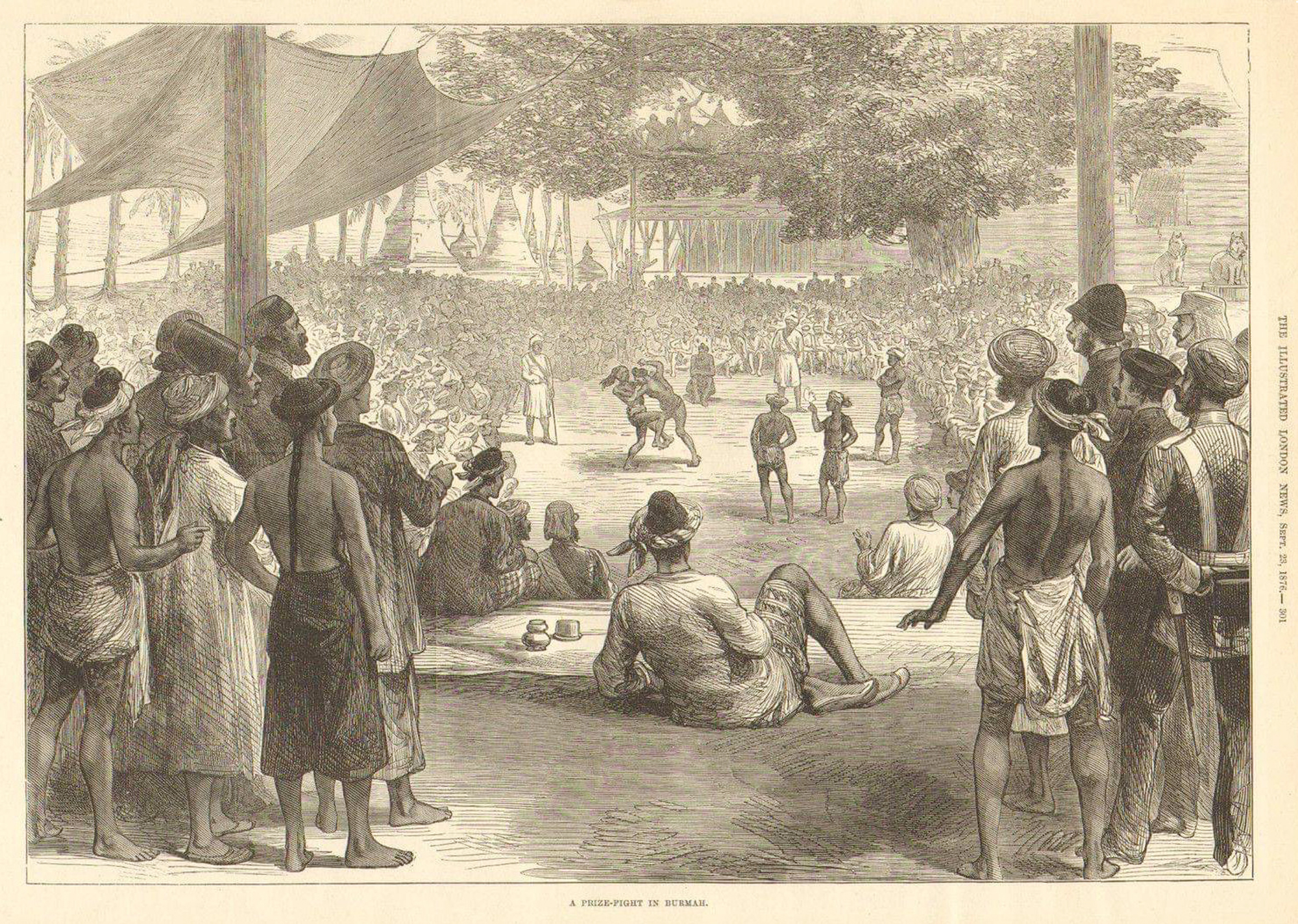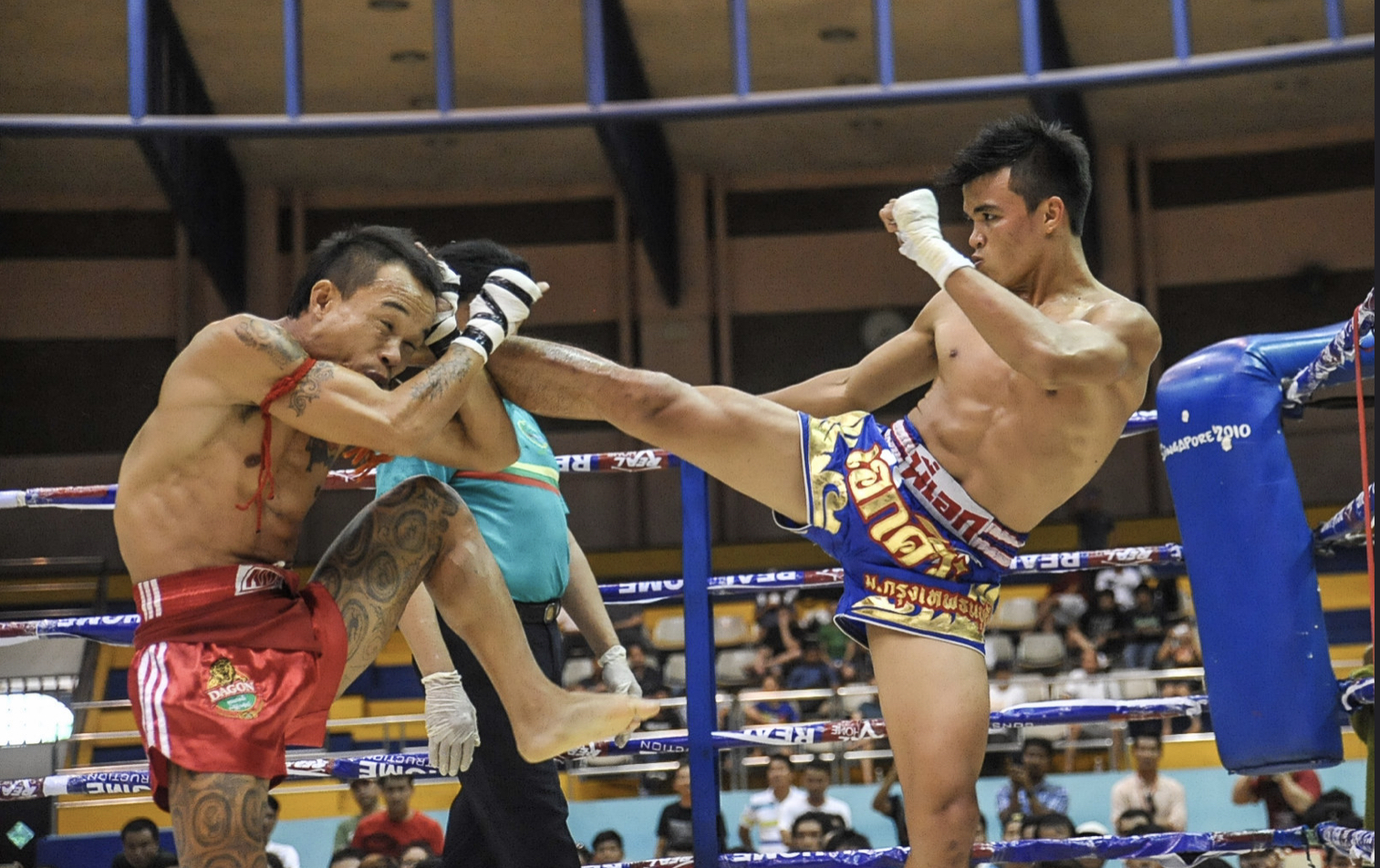LETHWEI AMERICA

Lethwei as a Combat Sport, Part 1
“Lethwei is linked to the identity of Myanmar . . .
it is a combat sport, a fighting art, and a culture.”
– Sayar Win Zin Oo
Martial arts traditions and fighting sports have always been an integral part of life in Myanmar (Burma). Lethwei, the art of bare-knuckle fighting is an age-old tradition that has been quietly maintained in rural villages throughout Myanmar for centuries. In ancient times, Lethwei was used as preparation for war and survival. It also served as a rite of passage for boys transitioning into adulthood. Hidden from the rest of the world for many years, Lethwei like Myanmar itself is experiencing a revival and rediscovery both at home and abroad.1,2
Lethwei is considered one of the most aggressive and powerful fighting arts in the world. Lethwei, known as the art of nine limbs, allows the use of fists, feet, elbows knees, and the head. In all other kickboxing styles headbutts are illegal, but Lethwei recognizes the head as essential to a complete and effective offense.3
Traditional Lethwei contests are held during festivals or as a special event during religious and cultural celebrations. Boxers often travel around the country in search of fights. Participants wrap their hands in hemp or gauze cloth. These wraps provide little in the way of padding and cause frequent cuts and abrasions. Fights are held outdoors in circular sandpits. Traditional Lethwei matches have no weight classes with fighters sized up and matched by experienced promoters or referees.4,5,6,7,8

Unique to Lethwei is the allowance that may occur during a fight that is called the “special rest”. This rule provides a second chance to the downed fighter. If one of the fighters is knocked out, his corner is given two minutes to resuscitate and rejuvenate the fighter so that he can continue with the match. Some say this rule survives from the days of grudge matches when an opponent was given any opportunity to avenge his wrong through Lethwei and if needed a second chance after being knocked out.4,5,7,9
Traditional Lethwei matches also required two officials or referees (one to represent each boxer) to uphold the rules of the fight. The referees would step in to separate the boxers after clashing, throwing and tripping techniques. There was also a chief referee, who in the present day is referred to as a “jury”, that would step in if any problems arose.5,10
In Lethwei there are few rules and restrictions. Hair-pulling, slapping, biting, eye-gouging and striking the genitals are all prohibited. Once the opponent is on the ground, the standing fighter cannot continue to strike his downed opponent. If both fighters fall at the same time, the use of elbows, knees, or the head are prohibited while on the ring floor.5,9,10
To grow Lethwei on a more global stage, some fight organizers have adopted the practice of other international combat sport competitions. The more recent adaptations to Lethwei are often referred to as Myanmar Traditional Boxing. This more “modernized” form of Lethwei known as Myanmar Traditional Boxing has competitors going from battling in sandpits to fighting in boxing rings and includes weight classes as well as timed rounds.4,9,11,12

Outside of Myanmar today, Lethwei is often taught as a component of expatriated Bando traditions. When practiced in this format, the Lethwei is typically a revised or “watered-down” version of what is and has been practiced in Myanmar. An example of this type of modified form of Lethwei is known as Hanthawaddy Burmese Bando Boxing and was introduced in the United States in the 1960s. Previously promoted by the American Bando Association, Hanthawaddy Burmese Bando Boxing, also called Bando Kickboxing, is a highly modified form of Lethwei that eliminates traditional Lethwei techniques and tactics including the use of bare-fist punching, headbutts, elbows, knees, throws, trapping, and all techniques within the clinch. Hanthawaddy Burmese Bando Boxing not only removed the traditional physical techniques and tactics of Lethwei, but also excludes the cultural practices and rituals associated with the sport such as the Letkkha Moun and the Lethwei Yay.5,9,13,14,15,16
These modified forms of Myanmar (Burmese) Boxing practiced in the U.S. and Europe do not provide the full range of the combat sport, martial art or personal defense aspects of Lethwei. Elimination of effective and time-tested Lethwei techniques, tactics, strategies, and traditions creates a generic form of kickboxing that does not represent the unique nature of Lethwei. Such an altered form of Burmese or Myanmar Traditional Boxing does not provide an accurate representation of the history, practice, honor, spirit, or fundamental character of Lethwei.
References
1 Calderon, J. (2014) Lethwei Boxing in Myanmar. http://www.cnn.com/travel/article/myanmar-lethwei-boxing/index.html
2 Simandan, V. M. (2015). Burmese Lethwei: An Ancient Tradition Lives On. https://www.simandan.com/burmese-lethwei-an-ancient-tradition-lives-on/
3 Onefc.com (2017). Facts…Needs To Know About Myanmar Lethwei. https://www.onefc.com/features/facts-every-martial-arts-fan-needs-to-know-about-myanmar-lethwei/
4 Mallon, S. (2005). Leth Wei & Khun Khmer Boran: Fighting Arts Of Burma And Cambodia. Journal of Asian Martial Arts, Vol. 14, No. 2
5 Gyi, M. (2000). Bando: Philosophy, Principles, and Practice. Private Publication.
6 MM myanmars.net (2015). Lethwei. https://www.myanmars.net/myanmar-arts/myanmar-arts-lethwei.htm
7 Giordano, V. (2012). Burmese Lethwei: The Ancient Art of Bare-Knuckle Fighting. Muay Thaimes. Vol. 6; No. 1.
8 Draeger, D. & Smith, R. (1969). Burma in Asian Fighting Arts
9 Courderette, M. (2017). Lethwei: Myanmar Traditional Boxing. Ginger Editions Publisher
10 Zin Oo, Win (2019). Communications.
11 MMAlife.com. (2017). The Burmese Martial Art of Lethwei. https://10 MMAlife.com/the-burmese-martial-art-of-lethwei/
12 MM myanmars.net (2017). Myanmar Kick Boxing. https://myanmars.net/arts/19050-lethwei-myanmar-kick-boxing.
13 American Bando Association. (2019). Bando Systems. https://americanbandoassociation.com/bando-systems/
14 Wikipedia. (2017). Bando. https://en.wikipedia.org/wiki/Bando
15 Martin, M. (2001). A Glimpse into the Traditional Martial Arts in Burma. The Journal of Burma Studies. Vol. 6
16 Simpkins, A. & Simpkins, A. (1992). The Nature of urmese Boxing. Inside Karate. June, 1992